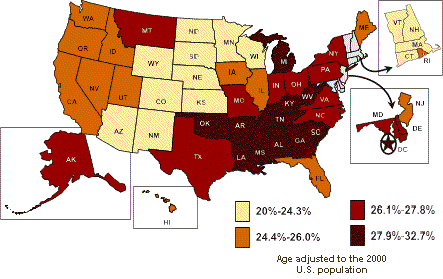 |

Home | Contact Us
|
|
|
|
|
|
|
||
 Home | Contact Us |
||||||||
|
|
|
|||||||
|
|
|
|
|
|
||
Percent of persons who were ever told they had high blood pressure, Adults aged 20 years and older, 2001.

Source: CDC, Behavioral Risk Factor Surveillance System.
[A text version of this graphic is also available.]
Statistics from CDC’s National Center for Health Statistics as published by the American Heart Association, Heart Disease and Stroke Statistics-2003 Update. Dallas, TX: AHA, 2002. http://www.americanheart.org.*
|
|
|
Privacy
Policy | Accessibility This page last reviewed September 23, 2004 Department of Health Human Services |